
Preface
Fieldwork in the north Chinese countryside remains tough, both physically and intellectually. With Chen Yu's Fujian background, and considering the wealth of care that southerners (despite being at the vanguard of economic development) continue to lavish on maintaining and researching their diverse local traditions, the northern countryside may seem an unpromising fieldwork base. But after coming north to study with Yuan Jingfang, Chen Yu soon realized there is much to unearth here too, and embarked willingly on the project. She is the latest in an outstanding genealogy of female music scholars: from Cao Anhe, through Yuan Jingfang and then Xiao Mei, down to the bright new generation with Qi Kun and Wu Fan.
Musical studies on north Shanxi were not so rare. From Chen Kexiu and Jing Weigang, to me, Zhang Zhentao, and then Wu Fan, we all set forth from Yanggao-and the fact that I'm still not done with the Yanggao yinyang is partly down to her prompting! We constantly float between national, regional, and local studies. And while village studies are always valuable, we need a good regional picture. Chen Yu now not only opens our eyes to the broader context, but makes important new discoveries-such as the substantial spread of hereditary household Quanzhen Daoists.
This is not only about geography; conceptually too, she is not limited to the old ideas of ancient shengguan music-the ‘living fossil fallacy'. Like Yuan Jingfang, she sees the place of shengguan within the whole body of ritual performance. Of course, [instrumental] ‘music' is often a vital component of ritual performance (the‘wind music' of‘wind music, percussion, writing, vocal liturgy, and Determining the Date'!), but her work-such as her concern to document not merely instrumental pieces but also ritual manuals (a first step, of course, while we await further studies from scholars of Daoism) -will contribute to transcending ideas like‘Daoist music', and updating our concepts from a nostalgic dream of Tang and Song to documenting the ongoing modifications to local cultures since the Qing dynasty.
Studies like this are also a step towards overcoming the long dominance of research on southern Daoism; apart from musicologists, few Daoist scholars deign to get to grips with local Daoism in north China-which is also why I wrote my 2010 book. The local Daoism that we find on this ‘Yellow Earth', the heart of early Chinese civilization, is very different from the south; but this is also Daoism, and it too repays study.
So I warmly recommend this book, and congratulate Chen Yu on her energy and thoroughness.
Stephen Jones
London,2015